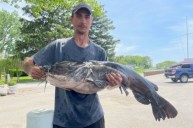Nature continues to astound us. It turns out that one blue catfish was destined for the record books, not once, not twice, but thrice!
In what must have been a very traumatic ordeal for the fish but good fortune for the angler, a blue catfish was caught multiple times — breaking the state records book in West Virginia each time. Recently, as documented on Facebook, Catfish guide Justin Conner hooked the monster blue. He was fishing with his fiance, Tabitha, on the Kanawha River when they made the discovery.
Speaking with Outdoor Life, Conner recounted his encounter with the blue catfish.
"There were still a few hours left in the day and we decided to try and locate some catfish," Conner, 37, tells Outdoor Life. "We headed to a flat rocky area in 10 feet of water that dropped off to 20 feet. My side sonar spotted some deep big fish. I dropped over my Spot-Lock and we bounced some mooneye cut baits deep behind my boat."
Blue Catfish Sets Records
Just 20 minutes later, Conner hooked a very large catfish. Meanwhile, his partner also hooked a big one as well. Talk about good fortune!
"It was pretty hectic with two big cats in strong current, trying to position the boat, getting our landing net, and trying to turn off the Spot-Lock motor to follow fish," said Conner. While Tabitha's wasn't a record breaker weighing in at 30 pounds, Conner's catch was bound for the records book. In fact, it was already there, and Conner had previously caught it.
"I knew right away it was a state length record blue cat," said Conner. "I also knew it was a catfish I'd caught previously that we call 'Spotty.' We weighed the fish, and did a quick length measurement, then I called the state DNR to document it."
The blue catfish weighed in at 66.30 pounds and was 51.49 inches long, a new length record. Meanwhile, Conner is certain that the fish is the same one that angler Mike Drake caught in 2023 to set a state record then — that time for weight. It's also the same fish that Conner previously caught as well.
"The fish has the same distinguishing features, including an overbite, two red scars on its lips, and the same black spot on its side, with the top fin appearing unchanged," says Conner. "Its weight varies depending on its diet, and the time of year. The fish also moves around a lot according to seasons, food supply and water conditions. This really shows how important catch and release is in preserving these trophy catfish."




